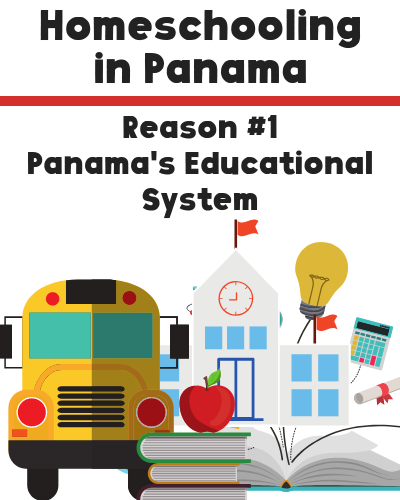
I had never even considered it as an option. Moving to Panama changed that.
Many expat families in Panama homeschool. Some of those, like me, had had no plan to homeschool before moving to Panama.
Deciding to homeschool can be scary. It feels like a lot to be responsible for your kid's education on top of everything else. I have since become pretty passionate about the benefits of homeschooling, but acknowledge it is not the right choice for everyone.
For a long time, I have wanted to share what I have learned about homeschooling in Panama. However, to be honest, I have been too busy with life and homeschooling our 2 daughters to tackle this large and complex topic.
2 recent events have prodded me to finally share my homeschooling experience and knowledge
As I look at all my notes for this article, I can already see that this topic will be better broken up into several articles. I will cover many topics in those homeschool articles, such as:
I will just start with the most obvious one: Why homeschool in Panama.
I am not going to go into all the reasons to homeschool wherever you are in the world, not just in Panama. Although, I will share a TED Talk video below which I find conveys a very compelling pro-homeschool argument, no matter where you live.
[leadplayer_vid id="5BB17319133C3"]
In this post, I focus on how the education offered in Panama is a reason to homeschool.
Many expats, and increasingly locals (esp. in Panama City) decide to homeschool because most schools in Panama are terrible.
Not all schools, but most.
At that 1st ever homeschooling conference, I asked a Panamanian mother who has lived in Massachusetts and Panama City about schools in Panama. I specifically asked whether she thought the expensive private school in Panama City were good schools. She replies that she was not impressed with the expensive private schools in Panama City. She homeschools.
However, I think these private schools are still a far superior option than other available local schools. Unfortunately, these schools very expensive and there are only available in a few areas in Panama. Most of them are located in Panama City, although there is one in David, One in Boquete and a few others elsewhere in Panama. A Google search will uncover many of them for you.
Panama's Almost-Last Place In Global Ranking
It is not just my opinion about schools in Panama. The last time Panama permitted its students to take the PISA test and get ranked against other students in the world, the results were dismal. The PISA test is taken by 15 years olds in countries around the world to assess their skills and knowledge. The intent is to help lower-income countries improve their educational system.
In 2009, Panama education was ranked 3rd from the bottom in the world. The only countries that ranked lower than Panama were Peru, Azerbaijan, and Kyrgyzstan. "The knowledge of a 15-year-old student in Panama is equivalent to that of a 12-year-old student in other OECD countries. Panama has a three-year delay in schooling," said Sebastián Grandchild.
(OECD stands for Organization for Economic Co-operation and Development, which is the parent organization for PISA. Check out this PISA link).
Since it's embarrassing 2009 ranking, Panama refused to be part of PISA test in 2012 and 2015.
Hope for the Future? New Rankings Soon
However, the new head of Education in Panama welcomed the testing this year (2018). The results are not in yet.
Importantly, Panama also participated in PISA's capacity needs analysis. The 2018 conclusion is that MEDUCA (Panama's education department) is severely lacking in staff, esp. staff trained in assessment. In addition, they found that Panama has no effective school assessment plan or tool. On the plus side, PISA says that Panama has the resources and the apparent will to create one and to improve its schools.
Crossing my fingers. Because, although there is a lot of government talk about the need to improve schools in Panama, not much has changed in the classroom. There has been a push & funds for more technology in the classroom. But the curriculum remains humanities-centric vs STEM-based, and there is a lot of pushback from the unions about changing the system. And of course, Panama's oligarchy-leaning system is not over-eager to better educate it's poor.
One reason Panama's schools are so bad is the typical teaching methods. Many schools emphasize rote memorization.
Also, teachers tend to value their students repeating the correct answer over developing problem-solving skills or deepening their understanding of a topic.
To give an example, schools are required to teach at least one class in English. I have had kids, one who is in a supposed English immersion school, read to me from their English books. They did great, although with some pronunciation issues. But when I asked them, what they read they could not tell me. They could read in English, but they did not understand it. Maybe they teach English comprehensive later, but I have been surprised by the lack of understanding from elementary school children.
Also, an amazing amount of classroom time is spent on copying. First, the student watches their teacher write a lesson on the blackboard. Then the child will spend even more time copying what the teacher wrote down into one of the many single subject notebooks they are required to use.
My younger daughter particularly hated the copying. She simply could not keep up with the kids who have been copying - and only cursive is allowed - for years. Plus she didn't even understand what she was copying down.
The same is typically done for homework assignments. Instead of distributing printouts of lessons or homework, the children have to copy them down. And they are graded on their penmanship - all in cursive. This doesn't leave a lot of time covering material or for questions. In fact, in our experience in Panama's schools asking too many questions is not encouraged.
Plus, there is an inordinate amount of busywork for homework. Cutting, pasting, and coloring feature strongly in the homework of elementary students. They even sell books to use to easily accomplish the required cutting and pasting homework. Before I discovered those books, I spent much time looking the required image in magazines or online to print so my daughter could accomplish her mindless homework assignment.
If you send your children to school, they can still learn and keep their love of learning alive. But it will take some participation by you. Perhaps they need some supplemental learning opportunities, or simply an open, "we love learning" attitude expressed at home to counteract the dullness they may experience at school. Thankfully, Panama's school typical schedule of ~7 am to 1 pm, this makes it easier to find time to do any needed supplemental learning.
Going to school in Panama does have strong advantages for expat kids, which I explore in a future article.
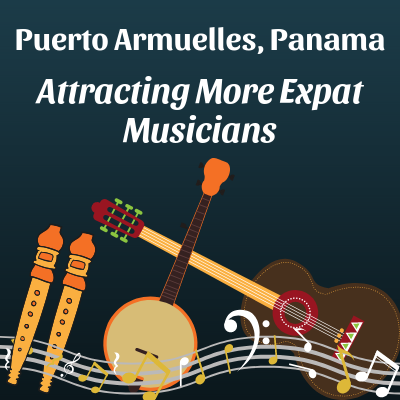
Over the past several years, I have noticed a steady stream of expat musicians arriving in Puerto Armuelles. I am not exaggerating when I say that I have met at least 6 new expat musicians who have moved here in the past year or two. No doubt there are others whom I have not met.
One expat musician, as you will see below, is offering to teach adults the recorder.
In the Corazon de Jesus neighborhood, there are 2 really good guitar players who live side-by-side in remodeled Panamanian concrete block houses. This is of particular interest to me since I have taken up the guitar as my “old guy hobby”.
Just this past week, I spoke on the phone with a couple who are curious about venues for performing their music in Puerto. They will be visiting Puerto for the first time soon.
So far, we have not had any sort of “open mic” nights in Puerto like the ones in Volcan or Boquete. However, with the arrival of so many musicians here perhaps a regular open mic event could be organized.
I know that Heavenly’s Hotel (Now Big Daddy’s) did have a few musical performances by local expat musicians. However, such events were not regularly scheduled. I will talk to Dave, one of the owners of Big Daddy’s Hotel, to see if anyone has expressed interest in performing lately. Hopefully, Big Daddy’s would welcome such a regular event. Come to think of it, Dave plays the drums. He doesn’t perform, but he loves music.
In Puerto’s Coronado neighborhood there is a family of musicians, Melinda, Ingrid, and Melinda’s son Ramy. They all play guitar. However, Melinda’s passion is the banjo. Not surprisingly, Melinda, in particular, is very enthusiastic and knowledgeable about bluegrass music.
Some very good news is that Ingrid is offering recorder lessons for interested adults. She is a retired music teacher from Anchorage, Alaska. As I mentioned above, Ingrid also plays guitar.
The recorder is a great instrument for learning the basics of music. And you can take it as far as you want to go. Ingrid has brought a number of alto recorders with her to Puerto so that she can assist those who want to give it a try.
(FYI, a basic recorder is easily purchased in Panama since the recorder is taught to most students sometime during elementary school.)
With luck, maybe she can even get a little recorder ensemble together. That sounds like fun.
If you are interested in lessons, contact Ingrid Lindberg of Puerto Armuelles via Facebook.
I'd be interested in taking up the recorder again. Many years ago, my brother and sister-in-law, both musicians, gave our family an assortment of recorders. We brought them down to Puerto over a decade ago, hoping we would starting playing the recorder. But it never really interested our kids nor my wife. (I had played a recorder for a couple of years as a child. I can’t have forgotten it all, I hope.).
I am going to dig through our various boxes of “stuff” and find those recorders. Then, I am going to get in touch with Ingrid to start re-learning the recorder. My attitude is that it is never too late to start to play music.
If you are a musician, or if you are interested in getting started playing music, please let us know. We'd be happy to steer you to others in Puerto who share your passion.
Thanks for reading, Reyn
Interested in Creating Art?
Check out more happiness-enhancing hobby suggestions
It pleases me to be able to repeat what I said 3 years ago
“No. There are still no hurricanes in Panama”.
In fact, there has never been a recorded landfall of a hurricane on the isthmus of Panama, Central America.
However, back in 1969, Hurricane Martha, with winds up to 90mph, was sighted 100 miles off the Atlantic coast of the Veraguas Province of Panama.
This category 1 (1 is the weakest, 5 is the strongest) hurricane weakened to a “tropical storm” with winds below 50mph before it finally made landfall in a rural part of Veraguas and quickly died out. There was no significant impact on the human population.
That’s about it, as far as hurricane activity in Panama is concerned.
As for more current weather events, on a Tuesday in August of this year (2018), we experienced high winds in Puerto Armuelles. That night wind gusts of 30-35 miles per hour toppled trees around Puerto Armuelles and caused residents to be without electricity. Most areas only lost electricity overnight, a few areas were without power for a day or two, and in the beach neighborhoods of Corazon de Jesus and further out for a few days.
We had to hire a neighbor with a chainsaw for a couple of hours the following day, to remove one fallen tree from the roadway into Corazon de Oro. That was the extent of the damage to our property. This windstorm encouraged me to have some preventative pruning done to other trees, which were overgrown, or posed a risk to power lines or fences.
Some areas of Panama are prone to heavy tropical rains during the rainy season. Generally, these do not affect normal human activities. However, in places like Panama City, where rapid development has outpaced the municipal infrastructure, flooding can be problematic from time to time. We have never seen this first hand, we have only read about it in the paper.
In the Chiriqui Province, there are places with heavy rains, and on rare occasions, there may be a temporary road closure due to flooding. On one particularly stormy November night about 6 years ago, we were driving from David to Panaso Canoas in knee-high in water. The flooding occurred due to the culverts being clogged by a recent mowing of nearby vegetation. That night, soon after we crossed it, a bridge went out. No one was hurt.
One of the most dangerous places on earth for Hurricanes continues to be the southern and eastern coasts of the United States. The “Sunshine State” of Florida is one of the worst for Hurricanes. It is the worst on all counts: frequency, strength, duration, and damage to property.
As I've said, Panama City, Panama (and all of Panama) has never had a Hurricane. Meanwhile, it's namesake, Panama City, Florida, has the nickname "Hurricane City". Panama City, Florida has had a constant barrage of Hurricanes and tropical storms batter its beaches over the years.
In fact, since records of hurricane activity have been kept beginning in 1871, Panama City, Florida has been hit by 60 hurricanes or major tropical storms. That is a major weather event every 2.43 years, with a Hurricane every 8 years. The next predicted hurricane in Panama City, Florida is expected within this very hurricane season, which ends this month. That is too much hurricane activity for me, but I am a bit of a worrier.
If you were to look at a map of major Hurricane activity in this hemisphere, the map would look like a map of the southeastern United States. To be precise, Florida, Louisiana Mississippi, Georgia, Texas, North and South Carolina, Virginia, Maryland, Delaware, New Jersey, New York, etc all the way up to Maine. All of these areas are far more vulnerable to hurricanes than the Republic of Panama.
Thanks for reading.
Reyn
Get news on living in Panama. Sign up for our monthly newsletter today.
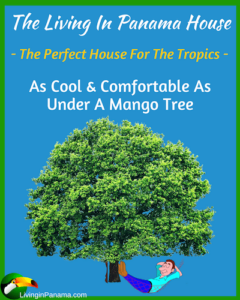
The Living In Panama House is, in essence, is a big covered porch, wrapped around the bedrooms and the bathrooms. Compare this with a more typical construction of a house with a porch attached.
Depending upon the model you choose, up to 75% of the house is an open-air secured and covered porch.
Our design gives you the same cool feeling as being in the shade under a big mango tree by the beach.
You’re protected from the sun, and there is nothing between you and the refreshing breeze.
Being under a big shady Mango tree at the beach is as cool as it gets here. That is, unless you turn on the air conditioning.
We are positive about this.
There is a big beautiful mango tree on lot 6 of our Corazon de Oro property, where we check the temperature throughout the day. It is the coolest spot around.
Made in the Shade of A Mango Tree
Why is it so cool and comfortable under a big shade tree with a cool breeze blowing?
This seems like a silly question. We all know it’s true.
However, when designing the perfect tropical house, you must ask, “Why is it true?"
1st - Mature Mango trees provide a wide area of dense shade.
The dense shade of the Mango tree protects you from the sun. Not only that, it also shades the ground all around you. This means that the entire area under the tree does not heat up, allowing you to stay cool and comfortable.
2nd - Mango tree branches are high up, so they don't block the ocean breezes.
Because it can easily flow under the Mango tree, the breeze is free to work its evaporative magic upon your skin, keeping you cool.
And, don’t forget about the psychological effect of air movement. Air flowing over our skin, makes us feel cooler, even if the temperature hasn’t changed. This phenomenon is known as the “perceived” cooling effect.
What else can we learn from the Mango tree, so we can build a really great tropical house?
Actually, that’s it. The secret to building a cool tropical house, believe it or not, is not to ruin this simple formula: Provide deep shade and don't obstruct the cooling breeze -- Shade, air movement, evaporation, and perceived cooling.
Most builders botch tropical houses because they build the way they always have. They don't stop to think about context, about what produces a comfortable house in the tropics.
Expats' Thoughts On Their North American Style Homes
From various studies and surveys, and through our own observations, we have learned a lot about expats who live in North American style homes in Panama.
How does the Living in Panama House bring together all the elements necessary to imitate the cool, comfort beneath our big mango tree? Shade, air movement, evaporation, perceived cooling.
The mango tree has these going for it. What about the Living in Panama House?
1st, the Living in Panama House has wide, 5-foot roof overhangs. This means that, just as if you were relaxing in a hammock beneath our big mango tree, you are protected from the sun by this big, sheltering roof. It also means that no part of the Living In Panama House, except the roof, is exposed to sunlight. By keeping the house structure from heating up during the day, you don’t heat up. What’s more, you will stay cool and comfortable all night.
Now, back to our mango tree comparison: The leaves at the top of the Mango tree get very hot, during the day, due to direct contact with the sun’s rays. Since a mango tree has so many layers of leaves, all that heat is trapped; It never gets to you, napping in your hammock down in the shade.
In the case of the Living in Panama House, we actually have the mango tree beat here. The mango’s tree’s thick canopy requires tons of branches and leaves to provide shade down below. Obviously, this is not a good model for building a house; It’s an inefficient use of materials), By contrast, The Living In Panama House has a metal roof, and galvanized steel roof framing.
Metal roofing is the most popular roofing in Panama, so it is readily available.
2nd, our metal roof system is very lightweight, or low in mass, which means that the roof can’t store heat.
3rd, the roof has a dramatically energy-efficient roof color, white. A white roof can reduce surface temperatures by as much as 100 degrees Fahrenheit, compared to a dark roof color. This means those solar rays are reflected right back into space. This is known as the Albedo Effect. The end result: a significantly cooler house. To learn more about why a white roof is the best choice for a cooler house, check out this article on the Texas Smart Roof, here.
4th, the metal roof is strong. It does not rest on top of the walls the way it does in typical house construction. Instead, the Living in Panama House roof is connected to the walls by a series of steel columns. The steel column supports are welded to steel reinforcement poured integrally into the concrete walls. This is the strongest roof design we have seen here.
Our Living In Panama House roof system is special in another way too.
5th, there is ample ventilation space to allow heat to escape and daylight to enter. In our current model home, there is 132 lineal feet of open ventilation between the roof and the top of the walls. At 2.5 feet in height, this ventilation system provides 330 square feet of ventilation, high up where you want it. (By comparison, a big 3’x 5’ double-hung window offers about 9 square feet of ventilation). This is just one of our vent systems.
What’s more, this high vent is not only a perfect way for the house to expel heat, but it is also the ideal location for clerestory lighting. This design, allowing natural daylight to enter the house high up, completely eliminates the dark, cave-like feeling that is found in many expat homes in the tropics.
Our tropical sun here is extremely bright. Without the extra effort to balance the lighting, the contrast between the blinding tropical sunshine and the relative dimness of the indoors gives an impression of gloominess. The interior daylight of most houses here makes you feel a bit as if you were in a basement apartment in the States. I like spaces that are light and cheery, so I find the interior light of theses homes depressing.
6th, There is no space where the heat will get trapped. Beneath the Mango tree, there are no walls (no doors, nor windows either). Nowhere for heat to get trapped. The Living In Panama House is similar, in that there is almost no floor to ceiling walls except in the bathrooms and bedrooms. (However, the bedrooms and bathrooms also have tall windows and doors for light and ventilation). The breeze can circulate freely throughout all of the living spaces, constantly exchanging the interior air for clean, fresh air right off the ocean.
7th, Long and lean design to allow free airflow. Another advantage to our design is that the Living In Panama House is long and lean, so the breeze can easily pass through the entire house.
Wide, fat houses are a mistake here in the tropics. That style of house requires more walls, plus interior hallways to access the spaces deep inside the house.
8th, Gable roof acts as a chimney to release any heat build up. The gable roof of The Living In Panama House is perfect for cross ventilation. Both ends are open. The peak of this beautiful roof is way up there, nearly 19 feet off the ground. There are no drop ceilings (unless you add them). This means there is a vaulted ceiling sloping upward from 13 to 19 feet overhead. We all know that heat rises. Since heat is free to migrate naturally upward and then be whisked away by the breeze, The House stays cooler. You stay cooler.
I have always loved the look of the old Chiquita Banana houses with their half-hipped roofs. You have probably seen them on our website, or maybe you’ve already visited Puerto Armuelles and seen them there. These roofs are a classic. They are part of the historic look of Puerto Armuelles.
When we first arrived in Puerto, I thought I'd like to copy the look of the Chiquita era homes, including the half hip roofs, but with a few design tricks to make them more efficient. To be honest, it took me a few years to finally accept the reality that hip roofs are beautiful and historic, but they don’t work.
Hip roofs, even half hip roofs trap heat. Even when they have those charming little wooden vents on the half gable ends In fact, the attic of our own Chiquita Banana House heats up to over 150 degrees on summer days. Finally, I had to let go of my love affair with the Chiquita Banana half-hipped roof.
9th, the Living in Panama house is designed for big ceiling fans for those days when the wind doesn’t want to blow. Ceiling fans are an attractive and efficient way to move warm air up and out of the house. They are a classic, tropical look that dates back over a hundred years.
10th, the Living in Panama house is A/C ready too. Obviously, not everyone wants to live without air conditioning. Some days, you just feel like going indoors and sitting in the media room, or the office, or taking a nap in a truly “chill” space. For that reason, the bedrooms, office/media room, and the bathroom zones are all designed for air conditioning. The decision to create an air-conditioned “cool zone” is up to you. These zones can be as big, or as small as you wish.
11th, easy to enclose more space over time. With our Living In Panama House design, it’s simple to enclose more space. You could even enclose it all if you really want to A/C the entire house. However, we suggest that you live in your new house for a while to experience what combination of fan vs A/C fits your tropical lifestyle. Then, with our system, it is very easy and fast to add walls, windows, etc, if you decide to adjust the Living In Panama House to your needs.
We think you will enjoy living in a Living in Panama House. If a Living In Panama House fits your needs, please let us know.
We will send you its construction plans. They cost $250 if you are not buying one of our properties. The plans are free if you do buy a property from us.
Don't forget, if you buy one of our properties, we are here to help answer your questions about the LIP House all along the way.
If you have questions, please feel free to contact us.
Explore Corazon de Oro: The most beautiful beach properties in Puerto Armuelles.

We updated & expanded our Places to Eat page to include:
Click to see this expanded Puerto Armuelles restaurant info.
Discover information on more of Puerto Armuelles neighborhoods:
You can now find info on all these neighborhoods:
Plus there are more photos.
I will be adding more photos over the next few weeks too.
To see this expanded neighborhood info, click here.
We hope you find this expanded info helpful.
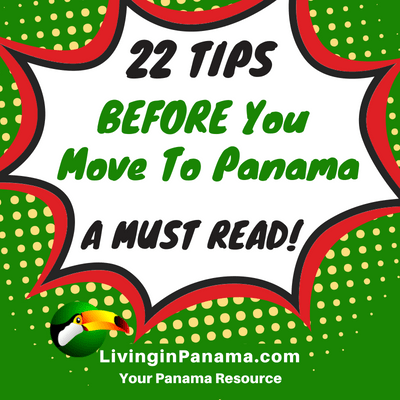
1. First, before you move, determine if Panama is right for you. To discover that, you should be clear on what you need to have in your life? What are the most important things to you? What will help make for a happy life?
If you go ballistic when the Internet (or electricity) is out and you cannot imagine life without readily available organic food or same day Amazon deliveries, you may need to rethink your desire to move to Panama. Be honest with yourself.
There are many wonderful places you could choose to live. It doesn’t have to be Panama.
Take our "Will Panama Make You Happy?" quiz to get a sense whether Panama is right for you.
2. Are you and your spouse/partner and/or kids on the same page? Your spouse's ideas about what he or she is looking for may surprise you. Your kids will be happier with the move if they feel you really listened to their thoughts and concerns. For a successful move, it is best to quickly get everyone involved in the decision process.
3. Manage your expectations. If you expect a trouble-free paradise, you will surely be disappointed. No place is perfect. No climate is ideal. No place is 100% crime-free.
4. Do you dream of finding a life partner in Panama? You may find one. But keep in mind, if you marry a Panamanian, there will be cultural and language challenges. For instance, when you marry a Panamanian, you are also marrying his or her family. Family is of paramount importance in Panama. Family members typically spend their Sundays together - all day. There is little buffer for cultural differences when you marry into the culture. The differences will be in your face, every day. To be happy, you will need to become accepting and tolerant very quickly.
Also, you should beware the Sugar Daddy/Mommy situation. That arrangement usually never ends well.
Successful Panamanian/Expat marriages can happen. I know a few expats who have been happily married for many years to locals they met after they moved here. But I know even more in which it was a disaster.
Of course, you may also meet a compatriot while in Panama and fall in love. Then you will encounter all the joys, trials, and challenges every relationship offers.
5. Panama is a different culture and lifestyle. The lifestyle issue is especially hard for Americans to come to terms with. The specific lifestyle issue I am taking about is convenience and customer service. If you are from the States, you are used to a level of convenience that no other country on earth offers. For example, many stores in Panama (and in many places in the world) are closed on Sundays. Also, in Panama and many other places, government offices close for lunch and many holidays. The entire country of Panama took the day off when the national team qualified for the 2018 World Cup. You need to get used to stores and offices being closed at inconvenient times.
Panama’s businesses are not set up to make the customer’s life easier and more convenient. It is something you need to get used to and plan for. Along those same lines, keep in mind that in Panama (and other places in Latin America and elsewhere) appointments and schedules are simply a goal, not a firm commitment. Expect to wait - not only to wait, but to wait without being annoyed about waiting.
6. Don’t drink and buy property. It can happen. You arrive in the land of palm trees, hammocks, margaritas, and cheap beer and your common sense tends to drift away. You meet a guy at a hotel bar, he buys you a few drinks. Then he's driving you around showing you property you could buy. “Look at that view”, he’ll urge you. “Feel that breeze. Boy, it doesn't get better than this. And, you know, there are only two lots at this price remaining. A couple of buyers are expected in town tomorrow. I'd hate for you to miss out…”
Would you buy a piece of real estate under those circumstances back home? A piece of property you are seeing for the first time, in a place you have never been to before? You need to do more due diligence when investing in a piece of property in another country - not less.
7. Speaking of buying property, there is no MLS in Panama. (Well, Panama technically has something called an MLS, but since the vast majority of property for sale does not appear on it, it does not function as an MLS as you know it in the States). In fact, only a handful of real estate markets outside the States have effective Multiple Listing Services. This means that your property search will not be very efficient, and that getting reliable information on comparable properties will be impossible.
8. Rent first. Don't buy property until you have made sure Panama is the place for you (and your companions). Even if you decide Panama is the right place for you, you may decide that a different area or neighborhood is a better fit. Renting gives you the time and flexibility to figure that out.
9. Panama might not be as affordable as you’ve heard. Where you live and how you spend will determine how affordable Panama is. For instance, Panama City used to be affordable, but not anymore. Like most major and popular cities in the world, living right on the water or downtown in Panama City can cost a lot. Expect to pay at least $1,200 to rent a decent place in the city (and that’s on the low end). In the high rent areas, your utilities and grocery costs will probably be more than you are used to paying back home, especially for items that need to be imported.
This doesn’t mean you can’t retire to Panama on a shoestring budget. You absolutely can. You just have to know how to do it. In most places in Panama, it is still very possible to rent a place for $200 - $500 a month. You can live well in many places in Panama on only $1200 a month. But you cannot do that in Panama City and it is harder to do in the more popular expat spots as well.
How and what you spend your money on also determines how affordable Panama is for you. See the next tip for more on that.
You can find more information on Cost of Living in Panama in various parts of Panama on my site and other places.
10. To save money you need to buy local brands. You have to learn to shop like a Panamanian. This means buying your fruit and vegetables from street venders. Not only will you save money on your produce, but it will be fresher. If you live in a small town where fishermen bring in their catch each morning, buy your fish off the boat, or at the local fish market. Again it is both cheaper and fresher that way.
Watch our video of buying fish off a boat in Puerto Armuelles.
If you insist on buying all the same food brands as you bought back home, you will pay more. Imported items cost more, more than they cost in their country of origin.
Also, Panama is not like the U.S., there is no Target or a Walmart where you can buy everything you need in one spot. You can do a lot of your shopping in places like City Mall, El Champion, and Discovery Center, where a they sell a wide variety of items. But you pay for that convenience. You may buy some items at PriceSmart (like Costco, but smaller), but other items at your local Romero grocery store, and still others from a street vendor.
If you learn what to do and what not to do, you can live well in Panama on a fairly low budget. Plus, you now have the time to enjoy the shopping experience.
11. Another thing about shopping, buying in bulk often costs more in Panama. In the States, if you buy a case of something, the per unit price will usually be less than if you simply bought one of those items. But not in Panama. (The exception to that rule is PriceSmart, usually, but not always).
I am not sure why. Perhaps the reasoning is that the person who can afford to buy in bulk can also afford to pay more. I know you might be shaking your head at that rationale. But Panamanians think about money and fairness very differently than most westerners. One of the many cultural differences you will get to know and, hopefully, embrace.
12. Your health insurance won't cover you once you leave the U.S. (and most other countries as well). Don't worry, you have options. Go to this link to start reading our series on health insurance in Panama.
13. Learn Spanish. Start now. Most Panamanians do not speak much English, if any. Yes, you can find English speakers at high-end hotels and tourist places, but in general you will not find much English spoken elsewhere. If you don’t speak Spanish, at least some Spanish, you will not only be frustrated, but you won’t be able to engage in the community and make friends with anyone but other English-speaking expats. Panamanian are wonderful people. It is worth the effort to learn to speak their language so they can be part of your life.
I review a few ways to learn Spanish online
14. You will regret your move - temporarily. There will come a time when you will frantically ask yourself, “What have I done! I must have been insane to leave my home and move here.” It happens to 98.7% of people who move overseas. Expect it and prepare for it. Remind yourself that nothing has changed. All the reasons you decided to move are all still true. You simply need to give yourself time to internally adjust to your new world.
15. Hire people to do stuff for you. What a joyful thought. You can now afford to have someone clean your house every week, or even every day. Don’t like yard work? hire a gardener to do it for you. It is pretty affordable. But it does have its challenges.
If you aren’t used to people making your bed and washing your dishes and clothes, it can take some adjustment. You may feel guilty or uncomfortable allowing others to do those things, especially if you are just hanging out while they are working. Think about how you will feel about lifting up your feet for someone to sweep under them while you are hanging out reading or chatting or watching TV. It can take some getting used to.
Then, there is the issue your maid putting your stuff somewhere you would never ever think of putting it. Breathe. It works best to simply learn where has decided your shoes should live. It is best to roll with these quirks of your workers. Focus on the big stuff, like learning about Panama’s employment compensation regulations, including social security payments.
Read more about hiring people in Panama.
16. Loud music is a part of life here. Stores will blast stereos in an attempt to grab your attention. Parties especially have loud music. I have been to a number of parties in Panama where the music was playing so loudly it was impossible to talk to anyone. A general chaos of noise is tolerated here. Once I was in a restaurant where both the stereo and the TV were blaring. I had to ask them to turn off the TV. We were their only patron so it was easily asked and complied with. But in general be prepared for loud music. This is something to keep in mind when deciding where to live. If you choose to live in a dense neighborhood, you may have to deal with loud music, especially if your neighbor decides to throw a party into the wee hours of the morning.
17. You will see lots of litter. It is common in Central America. Many expats visiting Panama will express their astonishment over the amount of garbage strewn on streets and beaches. Personally, I have seen many people simply drop their juice container or plastic bag on the ground when they had finished with them. In some neighborhoods in Panama City, people will pile their garbage in one spot, as if it were a collection spot, but it is not.
The good news is that the anti-litter forces are growing. In general, there has been a gradual change of attitude about littering in Panama. You will find more and more signs posted that admonish people not to litter. And more garbage cans are being installed in public places. Panama City has bought new garbage trucks and is increasing its collection range.
A friend of mine in Puerto Armuelles says that when her local school gave prizes for cleanest yard the whole neighborhood quickly became cleaner. The kids were bringing home the anti-litter lessons from school, and telling their parents. And thankfully, the parents started picking up litter too. And it seems that more and more people are coming together to pick up litter. Maybe you will decide to keep your street or beach clean, and encourage others to do likewise.
There has even been a growing push to recycle. I’ve started to see recycling bins in public places in Panama City, Penonomé, and David.
18. Stay in contact with friends and family back "home". Separation from family and friends is frequently cited as the hardest part of living in another country. Fortunately, technology has made it easy to keep in touch.
One good way to easily keep in contact is to have the important people in your life download at least 2 of the following apps to their smartphone.
Whatsapp is the texting/calling app of choice for almost everyone in Panama. WhatsApp allows you to call and text other people with WhatsApp for free. You do need an internet connection to use it, as you do for all such technology.
For live video communication, Zoom, Google Hangouts or Skype are good options. I especially like Zoom and Google Hang outs. If you are all iPhone users you could simply use FaceTime, which comes preloaded on all iPhones.
I encourage you to figure out how you will keep in touch before you move to Panama. Explore all the apps to discover which works best for you and your friends and family.
Find out more about cell phones in Panama.
19. Religion in schools. Religion is a part of the school system here in Panama - for both public and private schools. So, if you have school-age children, be mentally prepared for this. Whether you think religion in schools is a good idea or a bad idea, there is no escaping it (unless you homeschool).
Read about our experience with Panama schools
20. The customer is NOT right in Panama. You cannot expect to get the same level of customer service in Panama that you are used to back home. Of course, sometimes you will get great service in Panama. But it is best for everyone if you don’t expect it. Customer service is particularly bad at restaurants and retail stores. Service can sometimes be slow and seemingly unfriendly.
I think it is a cultural thing, graciousness is not necessarily emphasized in Panama. It is not that they mean to be rude, it is just that they don’t consider their actions rude. It is only rude through the prism of our culture. Of course, that doesn’t make it any easier or less frustrating to deal with. The real problems begin if you start to make a stink about it. If you thought that you had bad service before, you will most likely get worse service if you insult your server.
Keep in mind, bad service is not limited to restaurants and retail stores, you may also get it from businesses and governmental offices. If the electricity will be turned off because they are working on the lines, don’t expect any notification. They will just turn it off. It is usually only the expats that get up in arms about this behavior. The locals just shrug it off. The same is true of small businesses. For instance, if you hire a contractor they may show up late, or maybe not at all. They will not contact you about this.
You can treat the lack of good customer service as as minor annoyance or let it drive you up the wall. Most people adjust, but if you cannot, maybe Panama is not the right choice for you.
21. Need to make money? Come with a plan. If you are coming to Panama to retire on a fixed income, then this will not apply to you. But if you need to make money in Panama, it’s important to have a good idea of how you will make a living to support your lifestyle in Panama. Coming to Panama without a plan of action often ends in disaster.
There are a lot of money making opportunities for expats in Panama, especially if you are an entrepreneur. Just keep in mind that you must have a work permit, even if you only plan to work in your own business. (Note: If your work is solely online, you do not need a work permit.)
You may want to check out my articles about making money in Panama for more advice.
Think you will find a job here? Then you need to know that local salaries are low. Most jobs pay less than $1000 a month. Is that a workable budget for you? Of course, if you can find a multi-national or US company, with an office in Panama to hire you, you will likely get paid more.
You are unlikely to find a company to hire you and sponsor your work permit, unless you have a valuable skill to offer. Getting you a work permit costs them both time and money. In addition, the number of foreigners a company can hire is limited; most companies can only have 10% of their staff be non-Panamanian.
Also, if you are coming down here on job offer from a company, make sure to do some research first. Make sure that the company is reputable and that other expats have had good experiences working for them. You don't want to move down here, only to find that the job evaporated or the work permit never comes through.
22. Pay attention to your instincts. All your online research and calculations cannot substitute for the your gut reaction to being in a place. It is important to do research, but it won't give you the whole story.
I strongly recommend you visit Panama, especially the parts of Panama that most interest you, sooner rather than later. You will save yourself alot of time and emotional energy that way.
Get more information on moving and living in Panama. Sign up for our monthly newsletter.
Sources:
Our experiences, including being reminded of good tips by reviewing similar lists made by Kathleen Peddicord of Live and Invest Overseas and Chris at Panama for Real.
[leadplayer_vid id="5B3B70507C0EC"]
Transcript of video:
Hi! This is a look at Puerto Armuelles, Panama you can only get on foot.
My friend Veronique and I joined the local recreation group for this 5+ mile walk in the hills above Puerto Armuelles, Panama. We had a great time. We sang, laughed, walked and took in the sights.
The Hike
There was some uphill. But this section, you just saw, was the most steep, Most of the hike was pretty flat.
As I said, we did some singing and had a great time walking, talking, enjoying nature and the views.
After a bit, we dropped down into the Alto San Vicente neighborhood. Turned left towards town.
If you take a right, you see here, you’ll head out to Punta Burica.
Alto San Vicente Neighborhood
I've included some photos of some of the more rustic parts of Alto San Vicente I thought you might enjoy.
Downtown Park - Health Fair
We dropped down through the airport and ended up at the health celebration put on by the 7th Day Adventist church at the downtown park.
[A local gentleman says hello & good morning to me]
Raspados (Sno-Cones)
That is Ramon, one of the raspado guys. A raspado is a snow cone. In Panama, they off you the opportunity to put sweetened condensed milk on top, as well.
There were tables of the always popular Ropa Americana or used clothing for sale.
There was all vegetarian food - including some very tasty lentil & garbanzo bean patties.
The event offered blood pressure readings and all sorts of info to promote a healthy lifestyle.
Downtown Waterfront Park
This park is located by the playground and across the street from Puerto’s downtown waterfront park seen here.
Here is a quick peek at a view from he waterfront park that I took in the early morning.
Future Outings
A family, particularly Jose, are the driving force behind these biking and hiking outings.
If you go to one of the 2 Rosibel restaurants they own, (which are also the home of the delicious $1.75 lunch) you can find out when the next outing is.
They also have a Facebook group, you can see here.
Find Out More
If you want to learn more about Puerto Armuelles, or living in Panama, click the links below.
Thanks for watching!
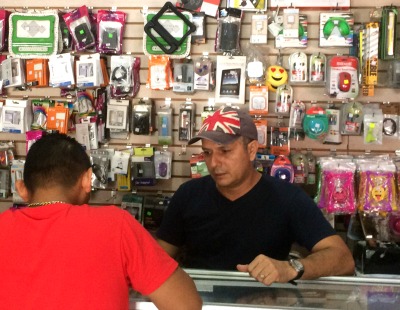
They also sell technology and accessories, such as:
Cell Phones, cases, chargers, power banks, routers, modems, mouse(s) (“Mice?”), all sorts of computer and electronic accessories, as well as watches and sunglasses.
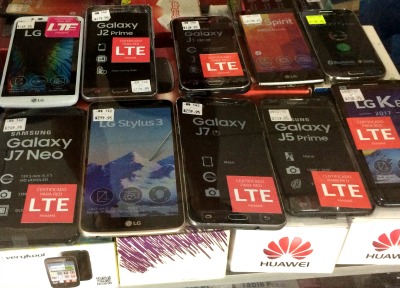
You used to be able to buy clothing and shoes there too, but no more. It is only a cell phone/tech store now.
Repairs Available
They also do repairs on cell phones, computers, and watches. See below for more on the repair crew.
On the main street, 150 meters down from Romero Supermarket, on the same side of the street. (see map)
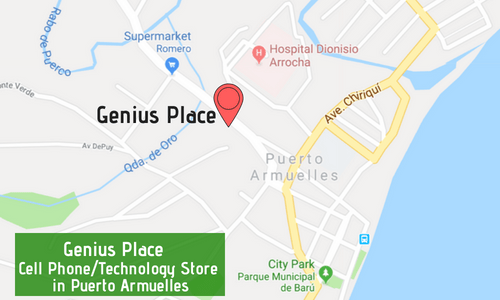
Open Monday - Saturday: 9am - 7pm. Closed Sundays.
Phone: 770-8024
I asked him how he came to name his business, Genius Place.
Where I come from, this would be an invitation for a lot of sarcastic comments.
Nextali explained that the name was “discovered” during the remodel of the building, before the store had even opened.
Nextali and the guys doing the remodel kept giving one another a hard time. “Oh thank you for passing me the nails…You’re a genius!” or “Hey Genius, can you help me move this scaffolding?” “No, you are the genius; I am but a humble assistant”, etc…
So that is how this useful and conveniently located store got it's name.
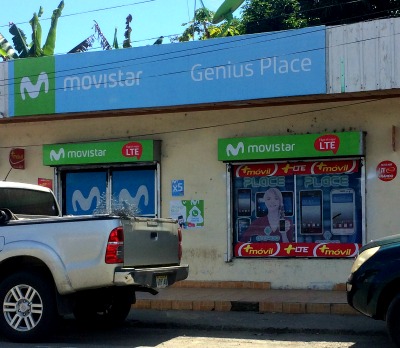
In 2003, Chiquita Banana Company closed its operations here in Puerto Armuelles for good. So, what does a company town do after the company has left the town behind?
Many people leave. But the loss of Chiquita Banana also enabled many entrepreneurs to start up businesses at bargain basement prices.
One such businessman is Nextali Montenegro, owner of Genius Place.
Nextali is from Paso Canoas, the town at the Costa Rica–Panama border, about 35 kilometers north of Puerto Armuelles.
Nextali's family has a long history in the retail business, having run successful clothing shops in Paso Canoas for more than a generation. After Nextali finished his university studies in business administration, he wanted to expand the family’s businesses into new markets. When he was 22 years old, Nextali saw Puerto Armuelles as the perfect opportunity to “get in on the ground floor.”
It has worked out well for him. Nextali owns the entire building where his shop is located, including the Uno Express courier service and the beauty supply store. So, as the market improves, Genius Place is poised to expand at their own pace. Genius Place has a second location in Bugaba, near the central park, and they have plans to open a shop in Volcan in the next several months.
Nextali is happy about the arrival of Del Monte in Puerto. Obviously, having so many new jobs in Puerto Armuelles is great for his cell phone business, since the cell phone, more than any other product, after food and shelter, is what working class Panamanians spend their money on. It’s the same all over the world.
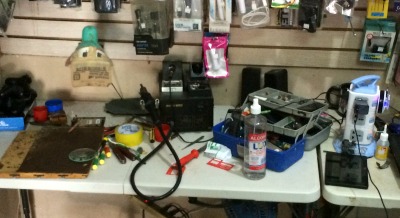
Nextali has two employees currently. Joel Aparicio, 29, is a graduate in cellular and computer technology and repair. He can definitely answer any of the usual questions that customers may have.
Joel is always eager to improve his English skills by working with ex-pat customers. However, his English skills are just fine for communicating and assisting with any computer/phone tech questions.
Kevin De Leone is 30. He is also a tech “geek”. Both he and Joel have their own work desks where they solder and repair cell phones, and many other repairs that come through the door. Kevin is not an English speaker. However, his good nature is apparent. There is certainly an air of good will and cooperation in the shop, much of it due to these 2 guys.
To give you an idea of the kinds of products and services that bring me, personally, to Genius Place, here’s an example. The other day, when I went into the shop to do the interview for this article, I realized that I had a couple of cell phone related tasks to accomplish while I was there.
First, I needed a new battery for one of our cell phones. “No Problem”, I was told. Within 5 minutes the new battery was installed.
Then, I remembered that I also needed to buy a power bank for another phone, an old iphone with a battery that barely held a charge anymore. They had several power banks to choose from.
I also needed assistance installing internet data on my cell phone. Nextali took care of this for me.
The final task may amaze some of you, if you are even reasonably tech savy. I had installed Whats App on my phone, but I could not remember how to use all its features. (To be honest, I forgot how to use WhatsApp completely.….I know. My wife Betsy, and especially my two daughters, give me no end of grief for being so technologically hopeless).
“No Problem”, I was told. Nextali explained to me, once again, all the features and how to use them. "Pan Cocido" (A piece of cake). Better yet, if I had asked any of the women in my family for help, they would have given me such a hard time for being such an “old fuddy duddy” that it would not have been worth asking for help. Nextali didn’t tease me once.
Check out Genius Place next time you need help with your technology.
Read my wife's article to get the basics about your cell phone and service options in Panama.
Find out more about life in Puerto Armuelles. Sign up for our monthly Living in Panama Newsletter.
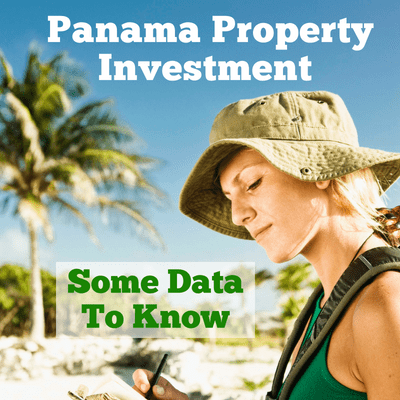
Here it is:
Foreign buyers are pushing up property prices in Panama. The average dwelling sales price surged by 21% from January 2015 to June 2017 in Panama's metropolitan area, according to the Panamanian Chamber of Construction (Capac) as reported by La Estrella de Panama.
Foreign buyers tend to be from the United States, Europe, Canada, and Latin America.
Yet at US$2,050 per square meter (sq. m.) in June 2017, the average price of residential properties in Panama still looks very reasonable, with metropolitan prices ranging widely from US$ 928 to US$ 2,892 per sq. m., according to Capac.
In Punta Pacifica, a collection of exclusive waterfront skyscrapers, high-end apartment prices are rising by 6% to 12% per annum, due to a shortage of available units. The average price in Punta Pacifica stood at around US$ 2,300 per sq. m. as end-2017.
Sales and construction were both up in 2017, says Maria Arias of TDI Real Estate. Arraiján and La Chorrera, where property prices start at around US$30,000, are specially active, due to infrastructure developments in Panama West and Panama East's constant growth.
It is a big turnaround. After the global financial crisis in 2008, Panama's dwelling prices declined by an average of 20% to 30%, according to Kent Davis of Panama Equity Real Estate.
Only after 2012 did foreign buyers return to the market.
Now it is the opposite story. Many infrastructure projects are approaching completion, and Panama's economy will continue to accelerate in 2018 and 2019.
Another boost to the market will be the new property tax law to be implemented from January 2019, which gives tax exemption to all primary residences worth more than US$ 120,000 (previously US$30,000), and generally reduces property tax rates.
Read about the new Panama property tax law
Tourist arrivals rose by 7.5% to about 2.5 million people in 2017, says the Panama Tourism Authority, with European visitors up 8.1% (though tourist spending only rose 3.8% to US$ 4.5 billion in 2017).
According to the Panama Tourism Authority, these numbers are expected to rise further since Air China now has direct flights to Panama. This will attract Chinese tourists.
Foreigners can own real properties in Panama, and are accorded with the same property rights as Panamanians. However, mortgages can be difficult to obtain, especially for foreigners, and the purchase process can take two to three months. More than 80% of real estate transactions involving foreign buyers are in cash.
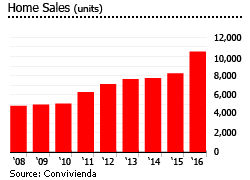
Beach apartments are increasingly in demand by both local and foreign buyers. The most popular areas include Punta Chame, Playa Blanca, Farallon, El Palmar (Hato River), Santa Clara, and Rio Mar (San Carlos).
Demand is supported by a stronger mortgage market. "The improvement in conditions for residential mortgages in recent years has been the principal promoter for housing," says the Superintendencia de Bancos de Panamá. Residential mortgages granted rose 10.1% to PAB 14.08 billion (US$ 14.13 billion) in 2017, as low interest rates and higher average terms increased the purchasing power of families. The interest rate on housing loans was 5.5% in December 2017, unchanged from the same period last year.
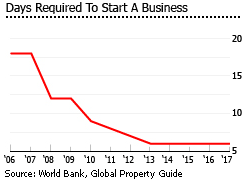
It requires only six days to start a business in Panama, according to the World Bank’s 2017 survey. Panama is the 2nd most competitive country in Latin America and the Caribbean, according to the World Economic Forum's Global Competitiveness Report 2017-2018.
Panama draws multinational companies and foreign investors with significant tax breaks, the free-trade zone, improved infrastructure, and a low cost of living. The expansion of the Panama Canal, which was opened in June 2016, is expected to bring in over US$2 billion in annual revenues by 2021.
“There are so many new businesses moving to Panama,” said Kent Davis of Panama Equity Real Estate. “It’s one of the reasons people are coming down – because there is still money to be made, locally, and as a regional base of operations.”
“People aren’t just moving here to relax,” Davis added. “They’re coming here to work because there is so much business around.”
Panama encourages foreign direct investment (FDI) in real estate by offering various incentives such as property tax exemptions, according to Jeff Barton of Punta Pacifica Realty.
Panama has the highest foreign direct investment (FDI) share of GDP in Latin America, at more than 10% of GDP, according to a United Nations report. Panama is also the largest recipient of FDI in Central America, with 44% of 2016's regional FDI total of US$ 11.97 billion. In 2017, the country's FDI rose by about 1.8% to about US$ 5.319 billion from the previous year, according to the Comptroller General of the Republic of Panama.
"The international community recognizes that Panama is a stable democracy and it is the fastest-growing country in Latin America," said Economy and Finance Minister Dulcidio De La Guardia.
For what it is worth, International Living’s Global Retirement Index names Panama as one of the world’s best places to retire in 2018, due to its convenience (ease of access from US, currency in US dollars, English is widely understood), world-class amenities, good beaches, and affordability.
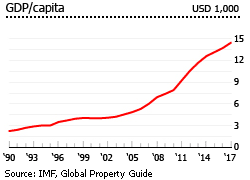
Panama has been removed from Financial Action Task Force's (FATF) "grey list", but money-laundering is still rampant.
In June 2014, Panama was placed on the "grey list" of Financial Action Task Force (FATF) of countries not doing enough to fight money laundering. FATF officially took Panama off its money laundering and terrorism financing watch list in February 2016, after new government regulations.
Despite this, money laundering and terrorist financing are believed still rampant in Panama. No real controls prevent funds moving through Panama to terrorist organizations, nor are do money laundering prosecutions actually take place. Moreover, Panama's powerful criminal syndicates remain fully operational.
In a recent report by the Latin America Financial Action Task Force (Grupo de Acción Financiera de Latinoamérica – GAFILAT), GAFILAT noted that the government's anti-laundering efforts are good, signalling progress in fighting money laundering. However, the report also pointed some deficiencies that the government must work on.
According to the GAFILAT report, the country was observed to be more susceptible to illicit streams of revenue from foreign sources than domestic ones. The GAFILAT enumerated the sectors of real estate, banking and corporate services, and free trade zones as the most vulnerable sectors to money laundering.
The task force also identified almost 730,000 businesses in the country that are considered at "high risk" of partaking in money laundering, during its investigation in May 2017.
Panama City is divided into two main areas – the old colonial town of Casco Viejo, and the modern business and shopping district of high-rise buildings and malls.
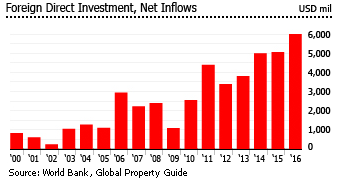
Panama's gross rental yields are still good, despite having declined over the past few years. Rental yields are range from 5.7% to 7.3%, with smaller apartments tending to yield more, based on the Global Property Guide research in November 2016.
Most properties in Panama City are apartments.
Based on the figures from Encuentra24, 2016 apartment prices in Panama City were:
Inland apartments ― ranging from US$ 1,900 per sq. m. to almost US$ 2,500 per sq. m.
Beachfront apartments ― ranging from US$ 1,800 per sq. m. to US$ 3,600 per sq. m.
Boquete, in Panama’s mountain highlands, has a fast growing expatriate community. The popular option here is to buy land and build a home, but there are many completed homes on offer.
Sample property prices for Boquete are as follows:
2-bedroom, 1-bathroom home, about 1,600 sq. ft. – US$90,000
3-bedroom, 2-bathroom home, about 1,500 sq. ft.– US$179,000
Another desirable location is Coronado, a popular beach town and relaxed community for expats, and only an hour from Panama City.
Sample property prices for Coronado are as follows:
3-bedroom, 2-bathroom home, about 1,300 sq. ft. – US$132,000
2-bedroom, 1-bathroom furnished condo, about 850 sq. ft. – US$135,000
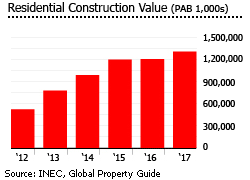
In 2017, the value of residential construction rose by 12.2% to PAB 1.29 billion (US$ 1.29 billion) from the previous year, when it rose by 0.6%m, after annual increases of 21.1% in 2015, 26.8% in 2014, and 48.8% in 2013, according to the Instituto National de Estadistica y Censo (INEC), all of which follows a decade of breakneck building which raised occupied housing units by 31.5% between 2000 and 2010, according to the National Censuses.
Total credits granted to the construction sector rose by 8.2% In 2017 to around PAB 6.74 billion (US$ 6.77 billion), according to Superintendencia de Bancos de Panamá.
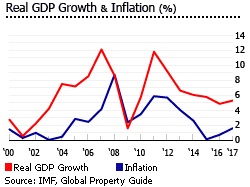
"This increase is explained primarily by the behaviour of economic activities related to the external sector. Among them, those of the Panama Canal, air and financial services stand out positively," noted a recent report of the Comptroller General of the Republic.
The US$5.25 billion expansion of the Panama Canal, which began in 2007, has experienced delays and cost overruns amounting to US$1.6 billion. But the expansion, which started operations in June 2016, has doubled the Panama Canal's capacity, with wider and deeper lanes and locks, and a new lane of traffic allowing more and larger ships. This year's tonnage of 403.8 million Panama Canal tons (PC/UMS) was the highest in its history, and a 22.2% increase on last year.
"These record figures reflect.... the Panama Canal’s continued ability to transform the global economy and revitalize the maritime industry," says Panama Canal's administrator, Jorge L. Quijano.
Major infrastructure projects scheduled to finish this year or in early 2019 include Panama’s metro system, the first in Central America. Line 1 was completed in April 2014, while the second line is expected to be completed in 2018.
The port of Colon upgrade is expected to be completed by the end of 2018, while the construction of the second Tocumen International Airport is currently in its final phase.
All these major infrastructure projects will improve the country’s connectivity, and breathe new life to the economy and the real estate market.
The economy is expected to expand by 5.6% this year, and further accelerate by 5.8% in 2019, according to the IMF.
After more than 10% annual GDP growth in 2011-2012, Panama’s economy slowed to 6.9% in 2013, 5.1% in 2014, 5.6% in 2015, and 5% in 2016, according to the National Institute of Statistics and Census (INEC).
The more moderate pace of recent growth reflects work delays at the Panama Canal (from August 2014, the completion date moved several times to June 2016), and the end of other public work projects, and the Colon Free Zone dispute with Venezuela and Colombia.
I have edited this Global Property Guide article slightly to make it easier to read.
Source: GlobalPropertyGuide.com